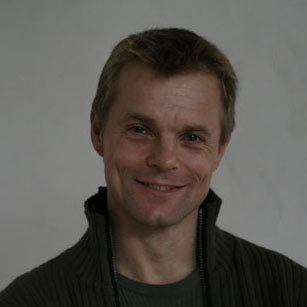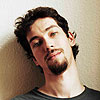



Home |
Contact |
CV |
Video |
Photos |
Music |
DVD |
Productions |
Sonic Body - Movement-Sound Interrelation structured Improvisation-Systems
Performances with numerous dancers and live music, moving and playing in a structured relationship.




Lately Henrik Kaalund has focused on methods of that allows performers to express in a direct, immediate and authentic manner, to utilize the creative potential in each performer, while each still contributes to a larger whole, forming what you could call “a piece” and creating a coherent group dynamic. While learning and perfecting set choreographic material certainly has it merits, in many cases improvisation allows greater freedom for spontaneous expression. But having the freedom to express everything any time may express nothing at all. If, however, you agree on a set of rules, ideas or goals for each situation and the combination of these composes a thought out structure, it is possible to unify the efforts of a group of people; the collected results will have a focus that will give the work a direction, a face, even though what the performers do individually is not set. And incidentally: the time it takes to create works this way can be much shorter, doing away with time consuming learning by heart of choreographic material.
As Ewa Wycichowska from Polish Dance Theater challenged him to create an evening length performance based on a workshop-week, The Coaching Project, during 'VIIIth International Dance Theatres Festival' 2011 in Poznan - Poland with only three hours rehearsal per day, he started working on systems to make these ideas function with the very limited time available. End of August the workshop took place with 15 dancers during the festival and resultedin a 50 Minutes performance. Here is a trailer of the results:
| Dancers: Aniela Brudnowska, Aina Gargallo Sanchez, AlicjaHoppel, Aleksander Kopański, Paweł Łyskawa, Eryk Makohon, Maria Aberbuch, Katarzyna Ustowska, Małgorzata Werbińska, Izabela Wysocka, Karol Miękina, Piotr Bumaj, Marcin Motyl, Oliwia Luethi, Niels Claes |
After successful implementation and performance in Poznan, the work was continued and deepened during the work-week 5th-10th of September 2011 at the performance space Mica Moca Berlin, where various additional aspects of the idea and other sound-movement concepts were investigated, culminating in a presentation of Sonic Body Boom there on September 11th, 2011 at 21:30, a performance of 1 hour duration, again with 15 dancers. Here is a trailer of the results:
Sonic Body Boom Dancers: see Sonic Body Boom Download trailer (save link as...)
Links to full download of these performances are available on request.
Other versions of the piece was presented at the Gallery Savvy; for an event at Mica Moca and at the studio K77 - all in Berlin.
The main overall theme in Sonic Body so far has been communication. All aspects of communication were considered, including haptic communication, spoken language, sign language, facial expression and body language; an emphasis was put on the communication between sound and movement. Some rhythmical principles were also a basis for the generation of movement. A number of signal-systems were devised and arranged into phases, for example:
- Voice to movement. Voice- and body-sounds from some performers, each triggering specific agreed upon actions or movements in other performers; a language was constructed.
- Signs. Gestures and movements from one performer inducing behaviors in a group of performers.
- Imitate as group. The performers improvise freely and at some point start to imitate someone else in the group or let themselves be imitated, after a while following the largest group. When all eventually move together, they follow the one in “front”, i.e. the one with the back to all the others. If the movement turns the direction in which everyone is facing, the one now in front is leading. An audio signal dissolves the unity and starts the whole thing again.
- Music instruments system. The group is divided into 3 subgroups, each listening and responding to one of three instruments. Each sound/pattern/melody of from an instrument induces movement modes, like “Cutting the space”; “Walking on clouds”; “Contact (with another person)”; “Around imaginary object” and others. The instruments can also speed up and slow down movement or start a loop of the movement that was just being performed.
There were other methods that with dealt musical principles, like moving for 8 counts, stop for 8 counts, move for 4, stop 4, likewise with 2 and 1, while keeping together as a group and an agreed pathway upon which to travel in space. A very simple principle, which nevertheless had a great effect.
In between these systems were miniatures of set choreographic material that had been made through tasks given to smaller constellations, duos and trios. The tasks were based on themes mostly kept within the theme communication, containing a mixture of themes like magnetic attraction/repulsion, giving/receiving of impulse, avoiding and receiving contact, creating spaces for the other and several other images.
An important part of the process was the collaboration with the musician and composer Kostia Rapoport (kostiarapoport.com), who made strange noises, rhythmical passages and was especially involved in the development of the mentioned Music Instruments System, for which he developed an intricate setup on his iPad (see photo below). Kostia was responsible for the complete audio of the performances and, apart from the iPad, played live keyboard (he is a trained concert pianist) and started recordings of his compositions on the fly. He is interested in participating again.
The performers involved in the process responded enthusiastically and with a high degree of involvement; the audience reported an equal enthusiasm and were captured by the challenge of deciphering the rules behind the actions. This positive feedback, combined with the exciting experience of seeing a larger group of people performing together with a common focus but still very much able to express freely as an individual, has encouraged the creators to continue this line of work and promoted a wish to further deepen and refine the details of it.
One advantage is that the methods work well on many levels of dancing skill. Naturally professional dancers will bestow a certain quality on the work but the images and ideas come through just fine with amateurs; people with other movement backgrounds or even untrained performers.
While there are certain principles that would remain the same, it would not have to be the same piece reproduced in future editions of the concept. There are several other ideas still to be tried out and the overall theme communication might be exchanged for another.
Creators:
 |
Henrik Kaalund - Idea/concept, movement elements, project director - www.kaalund.net |
 |
Kostia Rapoport - Concept associate, music director, musician - www.kostiarapoport.com |
This page is part of www.kaalund.net